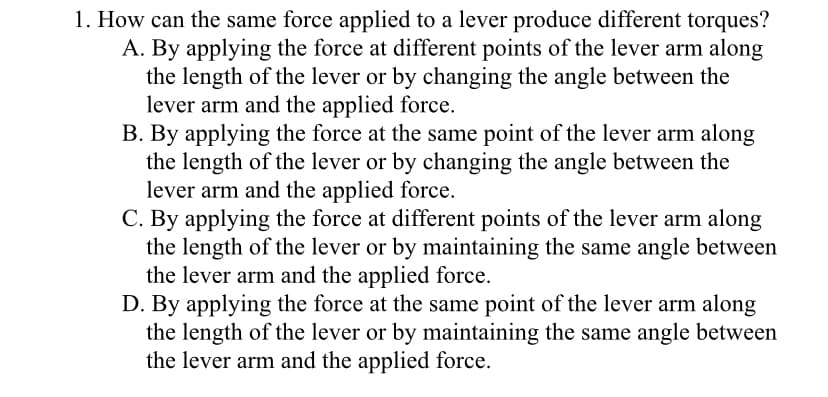1. How can the same force applied to a lever produce different torques? A. By applying the force at different points of the lever arm along the length of the lever or by changing the angle between the lever arm and the applied force. B. By applying the force at the same point of the lever arm along the length of the lever or by changing the angle between the lever arm and the applied force. C. By applying the force at different points of the lever arm along the length of the lever or by maintaining the same angle between the lever arm and the applied force.
1. How can the same force applied to a lever produce different torques? A. By applying the force at different points of the lever arm along the length of the lever or by changing the angle between the lever arm and the applied force. B. By applying the force at the same point of the lever arm along the length of the lever or by changing the angle between the lever arm and the applied force. C. By applying the force at different points of the lever arm along the length of the lever or by maintaining the same angle between the lever arm and the applied force.
College Physics
1st Edition
ISBN:9781938168000
Author:Paul Peter Urone, Roger Hinrichs
Publisher:Paul Peter Urone, Roger Hinrichs
Chapter10: Rotational Motion And Angular Momentum
Section: Chapter Questions
Problem 17PE: An automobile engine can produce 200 N m of torque. Calculate the angular acceleration produced if...
Related questions
Question

Transcribed Image Text:1. How can the same force applied to a lever produce different torques?
A. By applying the force at different points of the lever arm along
the length of the lever or by changing the angle between the
lever arm and the applied force.
B. By applying the force at the same point of the lever arm along
the length of the lever or by changing the angle between the
lever arm and the applied force.
C. By applying the force at different points of the lever arm along
the length of the lever or by maintaining the same angle between
the lever arm and the applied force.
D. By applying the force at the same point of the lever arm along
the length of the lever or by maintaining the same angle between
the lever arm and the applied force.
Expert Solution
This question has been solved!
Explore an expertly crafted, step-by-step solution for a thorough understanding of key concepts.
This is a popular solution!
Trending now
This is a popular solution!
Step by step
Solved in 2 steps

Knowledge Booster
Learn more about
Need a deep-dive on the concept behind this application? Look no further. Learn more about this topic, physics and related others by exploring similar questions and additional content below.Recommended textbooks for you

College Physics
Physics
ISBN:
9781938168000
Author:
Paul Peter Urone, Roger Hinrichs
Publisher:
OpenStax College

Glencoe Physics: Principles and Problems, Student…
Physics
ISBN:
9780078807213
Author:
Paul W. Zitzewitz
Publisher:
Glencoe/McGraw-Hill

College Physics
Physics
ISBN:
9781305952300
Author:
Raymond A. Serway, Chris Vuille
Publisher:
Cengage Learning

College Physics
Physics
ISBN:
9781938168000
Author:
Paul Peter Urone, Roger Hinrichs
Publisher:
OpenStax College

Glencoe Physics: Principles and Problems, Student…
Physics
ISBN:
9780078807213
Author:
Paul W. Zitzewitz
Publisher:
Glencoe/McGraw-Hill

College Physics
Physics
ISBN:
9781305952300
Author:
Raymond A. Serway, Chris Vuille
Publisher:
Cengage Learning

College Physics
Physics
ISBN:
9781285737027
Author:
Raymond A. Serway, Chris Vuille
Publisher:
Cengage Learning

Physics for Scientists and Engineers
Physics
ISBN:
9781337553278
Author:
Raymond A. Serway, John W. Jewett
Publisher:
Cengage Learning

Physics for Scientists and Engineers with Modern …
Physics
ISBN:
9781337553292
Author:
Raymond A. Serway, John W. Jewett
Publisher:
Cengage Learning